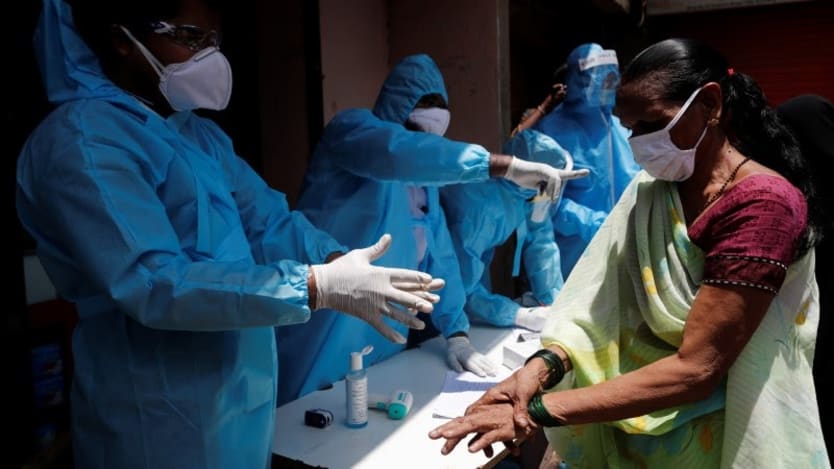
Following the spread of COVID-19 and increased economic volatility, recent forecasts from the World Bank, the Asian Development Bank, and the International Monetary Fund have projected a decline in Southeast Asia and the Pacific’s financial growth. For instance, the World Bank downgraded East Asia and the Pacific’s regional growth outlook from an estimated 5.8% in 2019 to anywhere between 2.1% to -0.5% in 2020.
As the region slips into a pandemic-induced recession, multilateral institutions have proven crucial in mobilizing and channelling funds to support the COVID-19 response, providing coordinated efforts to address the wider socioeconomic impacts of the crisis.
We’ve lifted our paywall on all COVID-19 coverage.
Looking for more in-depth global development funding insights? Please consider supporting our journalism with a Pro subscription.
Multilateral development banks and other international financing institutions have the financial firepower to help low- and middle-income countries face the impacts of the coronavirus crisis. COVID-19 response and recovery funds for low- and middle-income countries help deal with the health emergency, mitigate the social and economic consequences of the crisis, and strengthen and support coordination and collaboration across response efforts.
As a follow-up of our analysis of the bilateral funding in Southeast Asia and the Pacific, the Devex analytics team is now exploring the role of the multilaterals. Our methodology is the same as in previous articles: We have been tracking COVID-19 funding announcements since the beginning of the year and we are trying to provide an accurate picture of the funding landscape of resources to combat COVID-19 in different regions of the world.
As of time of publishing, Devex has tracked over $29.3 billion in country-specific interventions from multilateral agencies, including new and reallocated funds for both COVID-19 direct response and for COVID-19 related consequences such as fiscal measures and economic stimulus.
Keep reading for a breakdown of how much multilateral agencies are giving and where the funds are going, and interact with our visualization below and download the data from our dashboard for further analysis.
How much financing are global multilateral agencies providing in Southeast Asia and the Pacific?
In March, the World Bank Group allocated a $14 billion fast-track package to support LMICs in their COVID-19 response and recovery, composed of financing from the International Bank for Reconstruction and Development, International Development Association, International Finance Corporation, and reprioritized funds.
The bank also pledged $150 billion to $160 billion in broader economic financing over the course of 15 months to address the repercussions of COVID-19. This includes over $50 billion of IDA resources on grant and highly concessional terms. So far, the bank’s emergency operations to fight COVID-19 have reached 100 countries, where 70% of the world’s population reside.
Interactive: The bilaterals funding the COVID-19 response in Southeast Asia and Pacific
Nations in South Asia, Southeast Asia, and the Pacific have experienced a range of responses to the COVID-19 pandemic from bilateral donors in line with their different political and geopolitical objectives. Devex Analytics takes a deeper look at funding in the region.
The total World Bank funding toward the response and recovery of COVID-19 in Southeast Asian and the Pacific countries — excluding regional interventions — is currently $12.3 billion. This includes not only the fast-track facility projects, but also reallocation of funds that had not been used, and other health and economic development-related projects to mitigate the consequences of the pandemic. You can explore the 29 interventions in the dashboard below.
Marking its largest-ever health sector support to India, in April the World Bank approved $1 billion in funding for the India COVID-19 Emergency Response and Health Systems Preparedness Project, $350 million of which comes from the COVID-19 Fast-Track Facility. A month later, the World Bank approved another $1 billion in loans to accelerate India’s social protection response program aimed at providing social assistance to poor and vulnerable households affected by the COVID-19 pandemic.
Also in South Asia, the World Bank approved $200 million for Pakistan under the Pandemic Response Effectiveness project, $100 million of which is from the COVID-19 Fast-Track Facility, and is reportedly working on repurposing $2 billion to support Islamabad’s initiatives against the pandemic.
In May, the World Bank agreed to give a $500 million loan to Pakistan under the Securing Human Investments to Foster Transformation program, which includes supporting policy reforms to aid COVID-19 emergency response as well as improving access to health care and education, and supporting economic opportunities for women, among others.
To help prevent, detect, and respond to the COVID-19 pandemic and strengthen other South Asian countries’ public health preparedness, the World Bank has allocated $100 million to Bangladesh, $5 million to Bhutan, $7.3 million to the Maldives, $29 million to Nepal, and $128 million to Sri Lanka.
Countries benefiting from the dedicated COVID-19 Fast-Track Facility in Southeast Asia include Cambodia, receiving $20 million in credit to support Cambodia’s pandemic response; Myanmar, with a $50 million emergency loan for hospital improvements and public health emergency preparedness; and the Philippines, accepting a $100 million loan to support the country’s COVID-19 response and recovery. The bank also approved $7 billion in loans to Indonesia in partnership with the Asian Development Bank and the Asian Infrastructure Investment Bank.
According to the European Commission, the EU will support Asia and the Pacific with €1.22 billion ($1.38 billion). So far, Devex has tracked over $410 million specific funding for countries in the South, East Asia and Pacific — excluding Central Asia.
Aside from assisting the countries’ health responses, the EU support is directed at areas including financial support for key economic sectors such as the garment industry in Bangladesh, rural development and agriculture in Sri Lanka and Bhutan, as well as tourism recovery in the Maldives and Sri Lanka.
Pakistan received the most COVID-19 aid in the region at $168 million in humanitarian support, development programs, budget support, and assistance to civil society organizations. This was followed by Bangladesh at $125 million, Nepal at $84 million, Sri Lanka at $25 million, Bhutan at $13 million, and the Maldives at $3.4 million. It’s also worth noting that much of the EU funds will come from reprogrammed funds, and that in this analysis we have not added the funds on COVID-19 research and development managed by the EU-research program Horizon 2020.
Gavi, the Vaccine Alliance has been approving applications for reprogramming funding toward health system strengthening, including urgent initial funding of $29 million to 13 lower-income countries to support their response to COVID-19, helping them to protect health workers and boost surveillance and testing.
As of May 19, the following countries in Southeast Asia and the Pacific have received approval for the reprogramming of funds for a total of $13 million: Myanmar, Pakistan, Cambodia, Bhutan and Timor-Leste. Myanmar received the lion’s share, with $8.3 million provided for personal protective equipment, disease surveillance, laboratory readiness, community engagement, risk communication, and emergency response coordination. Bhutan and Timor-Leste are also approved to reprogram funds for the procurement of supplies, training, operational costs, and transportation.
Interact with the data:
What are regional donors doing?
The major regional financial institutions ADB and AIIB have both stepped up support to mitigate the effects of COVID-19, focusing on economic packages to cushion the potential for severe recession in the Asia-Pacific region.
In mid-April, ADB tripled its COVID-19 response package to $20 billion to help LMICs that are ADB’s member countries counter the economic and health impacts caused by COVID-19.
Gavi smashes replenishment target at virtual summit
The Gavi replenishment secured a record $8.8 billion in funding for 2021 to 2025, serving as a “real injection of confidence into the multilateral system."
The new package includes the COVID-19 Pandemic Response Option, or CPRO, under the bank’s Countercyclical Support Facility, a quick-disbursing budget-support facility to help countries mitigate the economic shocks caused by the pandemic and bankroll measures to curtail the spread of the virus.
India, Indonesia, and the Philippines have each taken on loans of $1.5 billion from CPRO to fund COVID-19 Active Response and Expenditure Support programs supporting government stimulus packages to expand social assistance programs, boost resources for COVID-19 prevention and control, and safeguard workers from the economic downturn.
Grants from ADB’s Asia Pacific Disaster Response Fund to help member countries strengthen their capacity to contain the spread of COVID-19 total $14 million for countries such as Mongolia, Indonesia, the Maldives, Pakistan, the Philippines, Tonga, and other Pacific small island states.
For instance, on March 31, $1.53 million was awarded to Micronesia, the Marshall Islands, Nauru, and Tuvalu to kickstart their disaster response plans. Under ADB’s Pacific Disaster Resilience Program, a further $14.9 million is allocated to neighboring islands Samoa, Solomon Islands, and Tonga to meet the immediate expenses needed for adequate public health services during the COVID-19 crisis.
Initially established to help strengthen Pacific islands’ resilience to disasters, on April 13, PDRP was extended to include health-related emergencies in the definition of natural hazards, allowing for the release of funds in response to the COVID-19 pandemic.
Taking longer than the other multilateral banks, on April 17, AIIB doubled its COVID-19 Crisis Recovery Facility to $10 billion to finance both public and private sector responses to the pandemic. So far, both India and Bangladesh have taken out loans of $500 million and $450 million respectively from the facility to expand testing capacity and strengthen health systems.
On top of this, AIIB allocated $1 billion in loans to Indonesia to support its pandemic response — $250 million as part of a co-financing program with the World Bank and the Islamic Development Bank, and $750 million as a co-financing project with ADB. Most recently, on May 28, AIIB approved a $750 million loan to the Philippines to tackle the public health and economic effects of the COVID-19 pandemic.
What other multilateral initiatives are happening in the region?
On April 22, the New Development Bank — the multilateral development bank set up by BRICS nations Brazil, Russia, India, China and South Africa — announced a $15 billion Emergency Assistance Program to provide emergency loans to member countries to finance direct expenses related to the fight against the COVID-19 outbreak or provide support to governmental measures contributing to economic recovery in member countries.
Interactive: An analysis of COVID-19 funding in West and Central Africa
Devex has tracked and analyzed how much COVID-19 funding goes to a region facing the biggest health emergency since the Ebola outbreak.
Under this program, NDB approved a $1 billion loan to India, aimed at supporting the Indian government its efforts to contain the spread of COVID-19 and reduce human, social, and economic losses caused by COVID-19, as well as a 7 billion yuan ($990 million) loan to China to address the health and economic consequences of the outbreak.
Meanwhile, the Inter-American Development Bank announced that it would make up to $12 billion available to countries requesting support for the COVID-19 pandemic and its consequences with a focus on an immediate public health care response, safety nets for vulnerable populations, financing for small businesses and measures to support an economic recovery. On April 13, the bank launched a three-year fixed rate Sustainable Development Bond for Indonesia priced at $3.4 million, to be managed by J.P. Morgan.
India, the largest country in South Asia and a non-traditional bilateral donor to the region, has also stepped up to play a leading role in regional relief efforts. In line with his Neighborhood First policy, Indian Prime Minister Narendra Modi in April convened counterparts in the South Asian Association for Regional Cooperation forum and proposed a regional COVID-19 emergency fund with an initial $10 million from his government. The fund currently amounts to $21.8 million after contributions from the other countries in South Asia: Bangladesh, Nepal and Bhutan, the Maldives, Pakistan, Sri Lanka, and Afghanistan.
In line with its strategy to help its member countries better address rapidly evolving global challenges, IsDB made a $2.3 billion commitment under the IsDB Group Strategic Preparedness and Response Programme to support member countries combat the health and economic impacts of COVID-19.
Following an assessment of each country's readiness to tackle the health crisis and economic repercussions of the pandemic, in particular the impact on small and medium enterprises, IsDB announced various financial packages totaling $444.5 million to nine member countries, including $182 million to Bangladesh and $25.6 million to the Maldives.
Finally, the Global Fund to Fight AIDS, Tuberculosis and Malaria has committed to make up to $1 billion available for the COVID-19 response through fund reallocation. Through its grant flexibilities program, the fund enables governments to repurpose 5% of already approved grant funding to address health preparedness and response specifically for COVID-19.
In the Southeast Asia and Pacific region, the largest portions of the initial funding of $112.5 million went to Indonesia at $8.93 million, the Philippines at $6.2 million, and Myanmar at $6.17 million. In addition, the Global Fund established the $500 million COVID-19 Response Mechanism to reinforce the response to COVID-19, mitigate the impact of the pandemic on HIV, TB, and malaria programs, and improve health and community systems.
Interact with the data:
For access to in-depth analysis, insights, and funding opportunities from over 850+ sources — combined with Devex Pro news content — sign up to a Pro Funding subscription online today or get in touch to learn about our Pro Funding group options.









